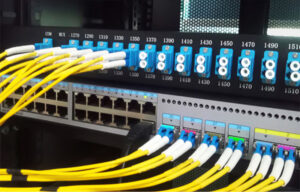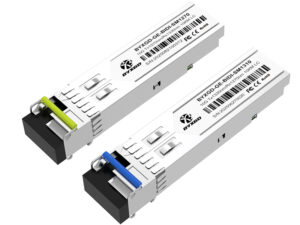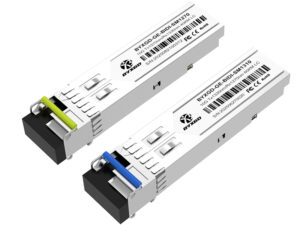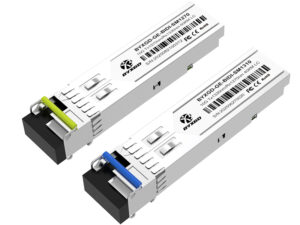Have you ever been subject to the limitations of fiber infrastructure when trying to increase the speed of your network? Just think about being able to increase capacity to 10G without having to run double the amount of fiber cables between your switches. The 10G BiDi SFP+ module will give you the ability to do just that, allowing you to have high-speed, bi-directional (sending and receiving) communication over a single strand of fiber sized for 10G.
This guide takes a deep dive into how the 10G BiDi SFP+ supports fiber savings, lessens complexity in deployment, and reduces costs to you and your customers. When you’re done, you’ll understand the key benefits of the technology, how to choose the right modules, how to troubleshoot problems, learn from examples in the field, and most importantly, you’ll be equipped to implement a single-fiber 10G solution confidently.

Why Choose 10G BiDi SFP+? The Key Benefits for Your Network
10G BiDi SFP+ modules are a game changer when it comes to network design and can support 10 Gigabit Ethernet over a single fiber strand. Traditional duplex modules will need two fibers, one for transmitting (Tx) and one for receiving (Rx), but the new BiDi modules are capable of using the same fiber to send and receive signals simultaneously.
Wavelength Division Multiplexing (WDM) is used to separate transmit and receive data, by using two different wavelengths, so in effect you are using two channels of data over a single fiber strand. You can think of the technology like a two-way street with a lane for each direction of traffic, allowing you to optimize the use of a narrow roadway.
Some other benefits of 10G BiDi SFP+ modules are:
- Fiber Savings – This approach can effectively cut the amount of fiber in a 10G Link, which has its own merit in areas where fiber may not be available or constrained.
- Cost Saving – Less fiber generally means spending less on fiber material and installation costs.
- Simple Cabling – Using a single fiber for transmit and receive signal reduces physical complexity and makes managing your network cleaner and easier.
Overall, deploying 10G BiDi SFP+ modules is good for deploying your practical long-distance cabling efficiently, lowering deployment costs while helping to maximize distance, speed, and reliability. For a little more of a deep dive into BiDi technology, click here.
10G BiDi SFP+ Product Lineup: Find the Best Solutions for Your Network
The 10G BiDi SFP+ product line includes a wide range of modules designed to support single-fiber 10G Ethernet installations with broad compatibility across major network vendors. These modules are designed to be dependable for high-speed performance and to maximize the utilization of fiber.
Typically, each available BiDi module covers a range of distances, wavelengths in short-reach (~10 km) and extended (up to 40 km) versions. Each module is clearly identified by a model number that indicates specifications of wavelength pairs and reach, making selection easy.

BYXGD-SFP+-BIDI-10G-Tx1270nm-Rx1330nm-10KM-LC: The 10Gb/s BiDi transceiver has transmission (Tx) and reception (Rx) capabilities over 10 km of single-mode fiber at 1270 nm and 1330 nm, respectively. The laser type is a Distributed Feedback (DFB) type with Tx power specifications of -1 dBm to -5 dBm and a receiver (Rx) sensitivity specification of ≤ -14.4 dBm. The transceiver interface format is LC.

BYXGD-SFP+-BIDI-10G-Tx1270nm-Rx1330nm-40KM-LC: This 10Gb/s BiDi module has a dual-wave operating mode. It transmits at a wavelength of 1270 nm and receives at a wavelength of 1330 nm, operating over a 40 km distance in single-mode fiber. It has a DFB laser with 0 to 5 dBm power and a receiver sensitivity of ≤ -15.8 dBm. The LC interface also makes it a snap to connect to your network.

BYXGD-SFP+-BIDI-10G-Tx1270nm-Rx1330nm-60KM-LC:The 10Gb/s BiDi module is capable of transmitting data at 1270 nm and receiving data at 1330 nm over a distance of 60 km for single-mode fiber. It contains a DFB laser with an output power of 0 to 5 dBm and has a receiver sensitivity of ≤ -20 dBm. The LC interface simplifies integration into your network.
Key 10G BiDi SFP+ Models and Specifications
| Model Number | Tx/Rx Wavelength (nm) | Max Distance | Fiber Type | Notes |
| BiDi-10G-SR-1310/1490 | 1310 Tx / 1490 Rx | 10 km | Single-mode | Common in campus networks |
| BiDi-10G-LR-1490/1310 | 1490 Tx / 1310 Rx | 10 km | Single-mode | Direction reversed from SR |
| BiDi-10G-40km-1270/1330 | 1270 Tx / 1330 Rx | 40 km | Single-mode | Extended reach option |
These options exhibit strong interoperability with leading switches from Cisco, Juniper, and Huawei, supporting seamless network integration.
User-Friendly Design and Features
- Quick and easy plug-and-play compatibility means you’re up and running in no time with little to no configuration needed.
- Modules operate at low power levels while also delivering reliable signal integrity.
- Compact design is compatible with standard SFP+ slots, making upgrades easy without modifying additional hardware.
Check out [SFP+ Modules Product] for more options and technical details to meet your networking needs. The set of modules really highlights how 10G BiDi SFP+ modules combine performance, fiber savings, and vendor flexibility to provide a great solution for many deployment scenarios.
The Ins and Outs of 10G BiDi SFP+ Performance
It is important to understand the technical aspects of 10G BiDi SFP+ modules as you make decisions about your network. 10G BiDi SFP+ modules work a little differently than traditional duplex 10G SFP+ modules, which helps with fiber utilization without sacrificing performance compared to traditional duplex modules.
The principle behind BiDi technology is wavelength division multiplexing (WDM), which enables the Tx (transmit) and Rx (receive) signals to operate on separate wavelengths over a single fiber. The challenge is that the Tx and Rx wavelengths must be paired precisely enough for each module to communicate properly. If the Tx and Rx wavelengths don’t match, the device will not work and may result in lost data.
Important Notes about 10G BiDi SFP+ Modules
- Tx/Rx Wavelength Pairs: These are simply two distinct wavelengths, like 1310 nm/1490 nm or 1270 nm/1330 nm, assigned to the transmission and reception roles.
- Transmission Distance: Ranges from a base level of 10 km, or standard, to premium set levels of up to 40 km.
- Optical Power Budget: In the ranges of -7 dBm to -1 dBm. The optical power budget is the gain of the transmitter signal level, ranging from possible distances and the type of fiber being used in transmission, in conjunction with the general error margin.
10G BiDi SFP+ vs Traditional Duplex 10G SFP+
| Feature | 10G BiDi SFP+ | Traditional Duplex 10G SFP+ |
| Fiber Usage | Single fiber per link | Two fibers per link |
| Number of Modules | 2 (one per endpoint) | 2 (one per endpoint) |
| Complexity | Moderate alignment of wavelengths | Simple fiber pairing |
| Cabling Cost | Lower (half the fiber required) | Higher (double the fiber) |
| Installation | Requires correct Tx/Rx wavelength match | Plug-and-play fiber cables |
| Typical Applications | Fiber-constrained environments | Standard fiber-rich environments |
| Maintenance | Slightly higher due to wavelength mgmt | Lower due to simpler setup |
Selecting 10G BiDi SFP+ modules can help cut the fiber optic cabling infrastructure in half, reduce both cost and footprint, while still delivering performance similar to duplex solutions.
Things to Consider When Selecting
- Right Wavelength Pairing: Make sure Tx and Rx wavelengths match each other precisely across the connected modules—this is important to ensure data communication won’t fail.
- Distance and Power Budget: Ensure the module’s optical power budget matches your intended distance and fiber quality type.
- Vendor Compatibility: Confirm that modules support your switch’s vendor protocols to avoid problems with detection and interoperability.
Taking care to vet these technical specs related to 10G BiDi SFP+ modules allows network engineers to choose the right module to maximize efficiency, cost, and performance in a single-fiber 10G deployment.
Troubleshooting: Common Problems & Solutions in 10G BiDi SFP+
Although 10G BiDi SFP+ modules provide some great features, there are some unique issues that have to be closely monitored, mostly concerning Tx/Rx wavelength mismatching, single-fiber issues, and general fiber transmission. To learn more, check out the article: “Troubleshooting and Repairing Optical Transceiver Failures in SFP/SFP+ Modules“.
Common BiDi-Specific Problems
- Tx/Rx Wavelength Mismatch: Each BiDi module transmits and receives on a fixed wavelength pair. Connecting mismatched sets of Tx/Rx wavelength pairs causes a failure to establish a link or introduces intermittent data errors.
- Single Fiber Problems: Since BiDi SFP+ devices utilize one fiber in both directions, if the fiber is broken or bends too sharply, the signal will not propagate correctly.
- Module Not Detected: An incompatible firmware version or an unrecognized vendor code will prevent the modules from being detected at all by switches and, therefore, prevent network traffic.
Methodology: Diagnostics Process & CLI Commands
- Confirm Wavelength Pairing: Check the model specifications for both modules to be sure that the connected Tx/Rx wavelengths are complementary in function.
- Inspect the Integrity of the Fiber: Physically examine the fiber for broken ends or damaged bends and clean properly.
- Check Each Module’s Status: Use such commands as:
- show interfaces transceiver detail→ reveals extensive information regarding wavelength, power levels, and errors.
- show logging→ event log may uncover hardware or firmware-related problems.
Best Practices
- Clean fiber optic connectors routinely to avoid dust interference.
- Avoid pinching connectors tightly, which will impair signal quality.
- Monitor for updates for the device’s firmware, keeping it upgraded for fixes.
- Perform routine checks on optical power levels to ensure they remain within safe operating limits.
Implementing these troubleshooting techniques will provide the most stable, high-speed single-fiber connection possible, while benefiting from the efficiencies of 10G BiDi SFP+ modules without sacrificing reliability.
Successful 10G BiDi SFP+ Deployment in a Fiber-Limited Network
A regional healthcare provider was challenged with limited fiber infrastructure as the demand for high-speed data transfer between multiple sites increased. The inability to upgrade legacy links was both costly and cumbersome as fiber was limited.
Challenges
- There was a limited number of fiber strands to support network expansion.
- The addition of cabling and civil work to support the upgrading was very costly.
- A reliable 10G speed was needed immediately without extensive rewiring of fiber.
Solution Deployment
The healthcare provider adopted using 10G BiDi SFP+ modules, which utilize single-fiber bidirectional technology that would double the capacity on a given strand of fiber. This allowed for the use of existing fiber without having to lay new cables and made the deployment much simpler.
The modules were grouped for wavelength pairs to guarantee that a link was established and operational across all sites. The solution was designed to integrate without having to replace any network equipment already in place by the healthcare provider.
Measured Benefits
- 50% of fiber was saved, extending the useful life of the fiber without installing new fiber.
- Deployment costs were about 30% lower without any physical cabling.
- Quick deployment with little downtime enabled the customers to quickly build on operational improvements.
This case shows that 10G BiDi SFP+ modules are a good way to obtain network scalability when constrained by fiber and will enable a scalable pathway to high-speed connectivity in a cost-effective way.
FAQ's
BiDi modules use a single fiber strand with bidirectional communication based on wavelength division multiplexing. Duplex modules rely on two fiber strands, one for transmit and one for receive. BiDi modules are more fiber-efficient since they require only one fiber to transmit and receive simultaneously.
Since 10G BiDi modules transmit bidirectionally over a single fiber strand, fiber polarity needs to be managed. You need to correctly pair relevant Tx/Rx wavelengths on each fiber strand to ensure proper signal handling.
Most 10G BiDi modules support distances up to 10 km, although some extended 10G BiDi modules are rated for distances up to 40 km. Actual distance supported depends on fiber quality (grade) and specification.
First check compatibility lists and firmware releases from the vendor. If purchasing from a trusted provider, support should extend across Cisco, Juniper, or Huawei platforms. Testing on a small scale helps assure success on larger deployments.
Contact Us For The Best Solution
10G BiDi SFP+ technology is an intelligent way to save on fiber resources, deployment costs, and labor by reducing installation time and improving the overall cabling of a network. If you can send and receive data over a single fiber strand instead of two fiber strands, you will maximize the efficiency of your existing infrastructure without sacrificing speed.
You can view a range of site-verified 10G BiDi SFP+ solutions, customized to the specific needs of your network. Don’t hesitate to reach out to your support specialist for further details and recommendations to help ensure a smoother transition to fiber-efficient, high-speed connectivity.
